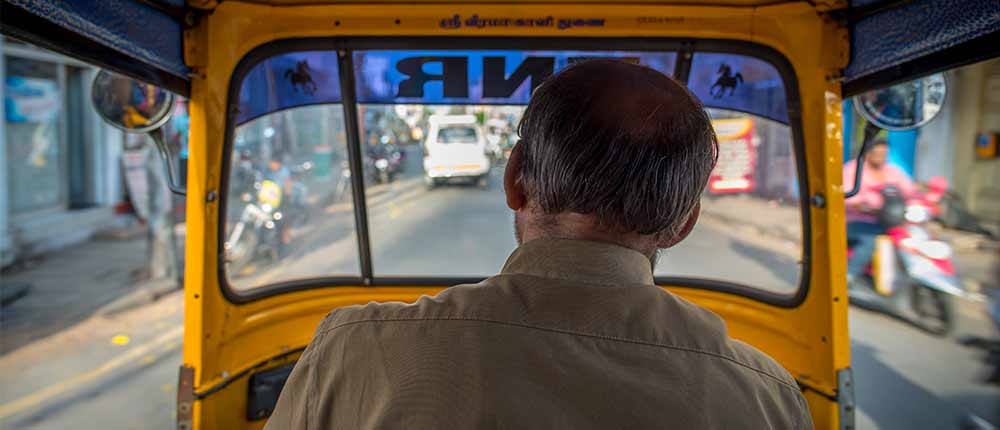TERI study suggests 1200 tonnes of carbon dioxide is emitted daily from total fleet of auto rickshaws in Bengaluru

The worsening situation of Bengaluru's road traffic requires immediate cognisance and action before the city chokes up in its own fumes. The infrastructure of the city has clearly not been able to keep pace with the fast development of the IT sector. The number of new vehicles that are registered every day and those that ply on the roads are constantly multiplying. This leaves the already toxic air of the city even more unbreathable.
A recent research paper released by TERI at a city event on public transport estimates and describes the status of tail pipe emissions in the form of carbon dioxide, particulate matter 10 (PM10) and nitrogen oxide emitted by two-stroke and four-stroke autos plying in Bengaluru. Based on data, it discusses the various scenarios to reduce the tail pipe emissions and derives the phase wise penetration of electric vehicles as the most recommended policy solution for the reduction of vehicular emissions.
As per the paper, in a day approximately 1200 tonnes of carbon dioxide, 4 tonnes of NOx and 0.5 tonnes of PM10 are emitted from the total fleet of auto rickshaws plying in the city of Bengaluru. In this, two-stroke auto rickshaws contribute 282 tonne, 0.1 tonne and 0.3 tonne of carbon emission, NOx and PM10, respectively. Roughly, a forest of 1.92 acres will be required to sequester the amount of CO2 emitted.
The gradual increase in the total number of in-use autos will lead to more consumption of fuel as well as increase in CO2 emissions with the other vehicular emissions (in spite of switching to LPG).
In Bengaluru, the total annual carbon emissions caused by the auto rickshaw sector is 0.44 million tonne. According to the business-as-usual scenario, with the addition of 1.5 lakh auto rickshaws in five years (as reported by RTO) there will be an addition of 0.5 million tonne of carbon emissions. Similarly, in case of vehicular emissions like PM 10 and NOx, the city is currently experiencing 170.14 million tonnes of PM10 and 1587 million tonnes of NOx annually. With the same addition of 1.5 lakh auto rickshaw in five years (as reported by RTO), this will lead to an addition of 212 million tonne of PM10 and 1,983 million tonne of NOx annually under the business-as-usual scenario.
Further, the potential for reducing vehicular emissions and contribution of transport sector to ambient pollution lies in switching to cleaner electric auto rickshaws which offer zero emissions. Currently, the Transport Department of Karnataka has notified a ban on two-stroke auto rickshaws. By switching to electric autos in Scenario III, the carbon emissions will reduce by 0.11 million tonne per year, PM10 will reduce by 114.5 million tonne per year, and NOx by 37.6 million tonne per year. Additionally, 0.17 million gram of LPG will also be saved which could be used as subsidy for the poor.
But, if the demand-supply gap is covered through replacement of 24,000 two-stroke auto rickshaws with four-stroke auto rickshaws, PM10 will reduce by 62%, CO2 emission will be reduced to around 0.02 million tonne and composition of NOx will increase by 21%. Thus, in order to reduce vehicular emissions, electric autos should be promoted.
With the current policy landscape, the Bengaluru transport department is promoting electric autos. However, adoption of a phase wise approach is recommended to introduce penetration of electric vehicles in the Bengaluru city. With 30% replacement of four-stroke auto rickshaws with electric ones, the observed carbon emissions are 0.24 million tonne per year, while those of NOx and PM10 are 985 and 35 tonne per year, respectively. With 60% fleet replacement with electric, the observed carbon emissions are 0.14 million tonne per year, NOx and PM 10 are 563 and 20 tonne per year, respectively. The complete replacement with electric will lead to zero tail pipe emissions and save 0.74 million gram of LPG.
The policy recommendations suggested by TERI are formulated in consultation with Transport Department and the auto drivers. The research paper recommends both direct and indirect benefits to the auto drivers in the form of direct incentives like subsidy, tax waiver, permit waiver and indirect benefits like dedicated free parking space and electric zones within the city. However, these interventions require support infrastructure for easy penetration of electric autos into the system.
The research paper is part of a study funded by European Union's Switch Asia on 'Switching to a sustainable auto-rickshaw system'. The project is being implemented by consortium of The Energy and Resources Institute (TERI), Fondoziane ACRA, ENVIU Foundation, Women Health and Development (WHAD).
